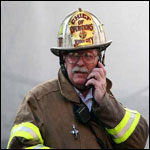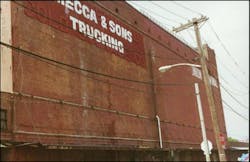Cobb: Jersey City Firefighters Heed Worcester Lessons Months Later
They spoke.
We listened.
We Learned.
Sometimes it's the lessons we learn from past tragedies that save the lives of the living. Never were such lessons learned more apparent than on March 22, 2001 when Jersey City, NJ, fire dispatchers transmitted Box 272 for smoke coming from a vacant cold storage warehouse. Located in the area of the Holland Tunnel, the "Mecca Building", as it was known by firefighters had been the scene of numerous fires over the years.
The typical call was usually a routine rubbish fire caused by the small community of homeless people, who continually forced their way in and inhabited the structure. The building was eight stories high and larger than two square city blocks; the interior was, for the most part, a windowless maze. The combustible walls were lined with Styrofoam, cork insulation and asphalt. Several of the elevator shafts were partially filled with old wood pallets. Many of the responding members of the Jersey City Fire Department were probably sizing up the call as another pain-in-the-neck rubbish fire in the Mecca Building.
If this scenario is starting to sound familiar, you're right. This fire began very much like the Worcester Cold Storage Fire on Dec. 3, 1999 -- a "routine" rubbish fire. From the beginning there was nothing routine about this response, either. The normal first and second alarm companies were busy at a two-alarm fire in an occupied residential high rise just a few blocks away. Some of the key first alarm units would be delayed, including Deputy Chief Timothy Kearney, who was the City Wide Tour Commander.
The first companies arriving at the scene reported heavy smoke with trapped occupants at the stairwell windows (the only windows in the building) on the southwest corner. A second alarm was transmitted by 3rd Battalion Chief John Austin and additional companies were assigned. With the high-rise fire under control, Deputy Chief Kearney responded to the warehouse fire. Ladder 12 and Ladder 3 raised their aerials to the upper floors and rescued two victims. First-due engine companies stretched 1 3/4- and 2 1/2-inch handlines into the interior. The initial size-up put the fire on the first floor. The rescued occupants reported many more of their friends might be trapped in the interior of the building. As engine companies began to attack the fire, other companies began searching for victims on the upper floors.
Before we continue, let's flash back a few months earlier to the seminar at New Jersey City University where members of the Worcester Fire Department spoke about a cold storage warehouse fire that claimed the lives of six firefighters. Several contributing factors learned and used during the incident in Jersey City can be attributed to the Worcester Fire Department. The Worcester Fire Department contingent was led by District Chief Mike McNamee. Their story wasn't just about what happened that day, but why it happened, and the causes and consequences of not expecting the unexpected. Any firefighter that was at the seminar that day and listened to Chief McNamee as he and the Worcester Fire Department bravely and courageously presented their story could only want to react by encouraging their departments to force change and make the fireground safer.
Many Jersey City firefighters were in the audience that day; they listened and learned the importance of crew integrity and fireground accountability as well as the advantage of using thermal imaging cameras. In the Jersey City fire, Rescue 1 Captain Pete Griese's use of spray paint to mark the floors was in response to what he learned from the Worcester firefighters; they became disoriented and couldn't relay what floor they were on to rescue teams. Other Jersey City firefighters and officers remembered the importance of search ropes as a tool to stay oriented. Search ropes were deployed by companies at the Mecca fire just two months later.
The day after the seminar, Deputy Chief Tim Kearney and I met with the members of Worcester for lunch and we discussed the similarities in our two departments' size, equipment and operations, as well as the Worcester fire. Just a few weeks later Deputy Chief Tim Kearney would find himself battling some of the same circumstances as District Chief Mike McNamee had. Deputy Chief Kearney said that several times during the Jersey City incident he thought about the Worcester warehouse fire and the lessons learned.
The initial strategy at the Jersey City warehouse fire was an extremely cautious offensive operation: Several homeless occupants were rescued immediately and they reported other victims may be trapped (possibly more than a dozen.) Deputy Chief Kearney paid particularly close attention to progress reports from interior operations. Company officers utilized search ropes and thermal imaging cameras as they searched upper floors. Battalion chiefs were assigned to the interior to monitor fire conditions and track the location of companies. Engine companies inside the Jersey City cold storage warehouse doused the flames with water, trying to keep the fire in check on several floors while searches continued. A report stated that fire may have spread into the elevator shaft. On the upper floors, Ladder 12 radioed negative results on civilian searches. They reported that, due to heavy smoke and heat, they were unable to return through the stairwell. They were heading to the roof. As Chief Kearney assigned a rapid intervention crew (RIC) to find and assist Ladder 12, Ladder 12 had made it to the roof and found another stairwell with less smoke and heat; they were able to return to the exterior. Now 45 minutes into the incident, Kearney assessed the situation and determined that primary searches were completed where possible and ordered an immediate evacuation of the building. All members exited and were accounted for.
At this point Deputy Chief Kearney ordered a defensive operation, an expanded collapse zone was established and only aerial and unmanned master streams were used. The defensive operations began at approximately 1 p.m. on March 22 and the fire wasn't extinguished until 12:45 p.m. on April 3. The net result of this operation included several occupants rescued from a building that was a total loss and only three firefighters and two civilian's sustained minor injuries.
The day Worcester District Chief Mike McNamee spoke at New Jersey City University's "Safety and Survival Seminar," he may have spoken all the words, but it was the spirit of our fallen brothers, Paul, Jeremiah, Thomas, James, Joe, and Timothy, who said the most. We thank you, Worcester. We will never forget!
ROBERT "BUTCH" COBB, a Firehouse.com Contributing Editor, recently retired as a Deputy Chief with the Jersey City, NJ, Fire Department. Chief Cobb was a member of the group who founded the Worcester Safety and Survival Seminar to honor the fallen firefighters. Cobb is the director of Community Hazard Mitigation for the Insurance Services Organization (ISO).

Robert Cobb
Robert “Butch” Cobb recently retired as a Deputy Chief with the Jersey City, NJ, Fire Department. Chief Cobb was a member of the group who founded the Worcester Safety and Survival Seminar to honor the fallen firefighters. Cobb is the director of Community Hazard Mitigation for the Insurance Services Organization (ISO).






